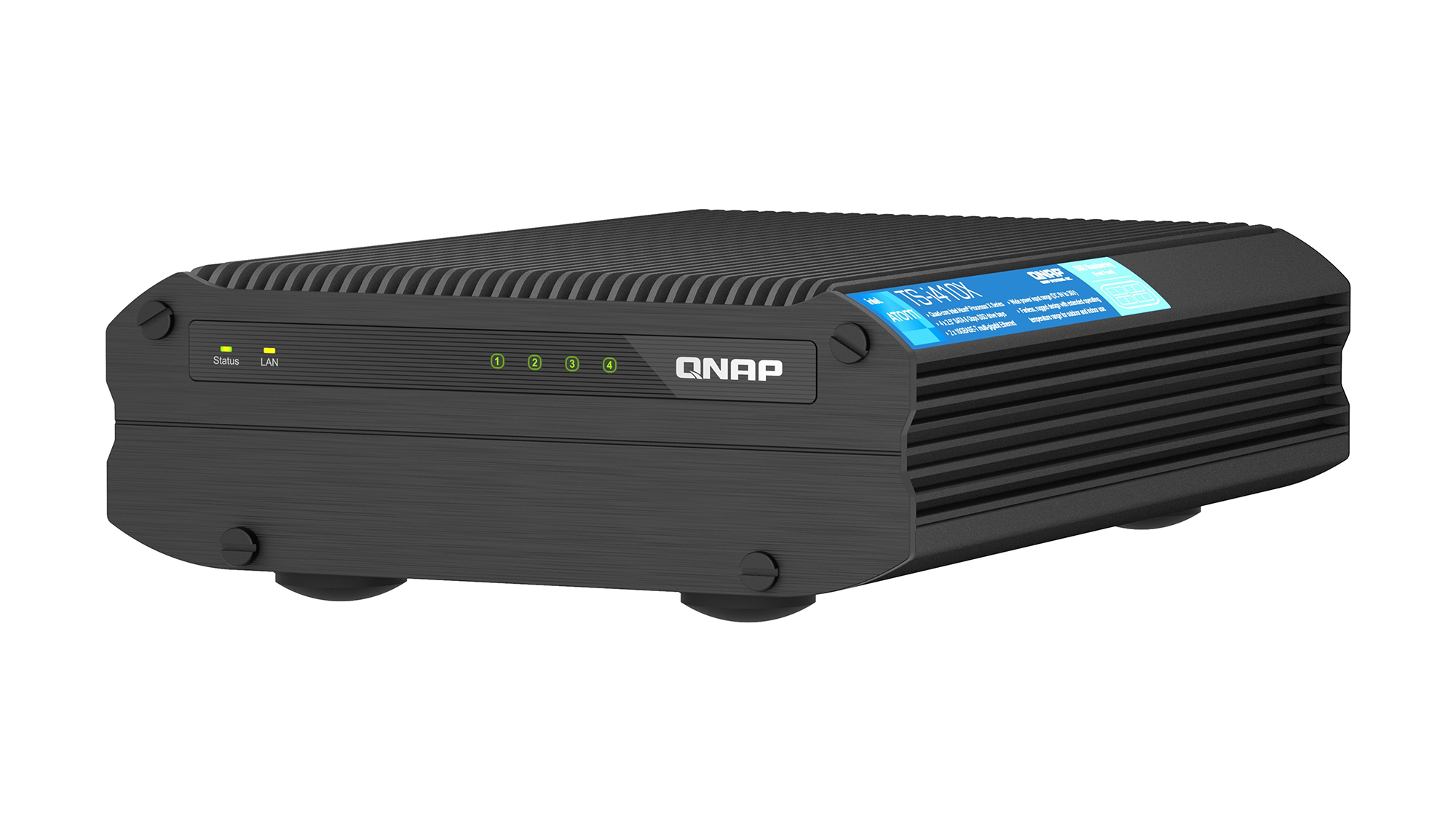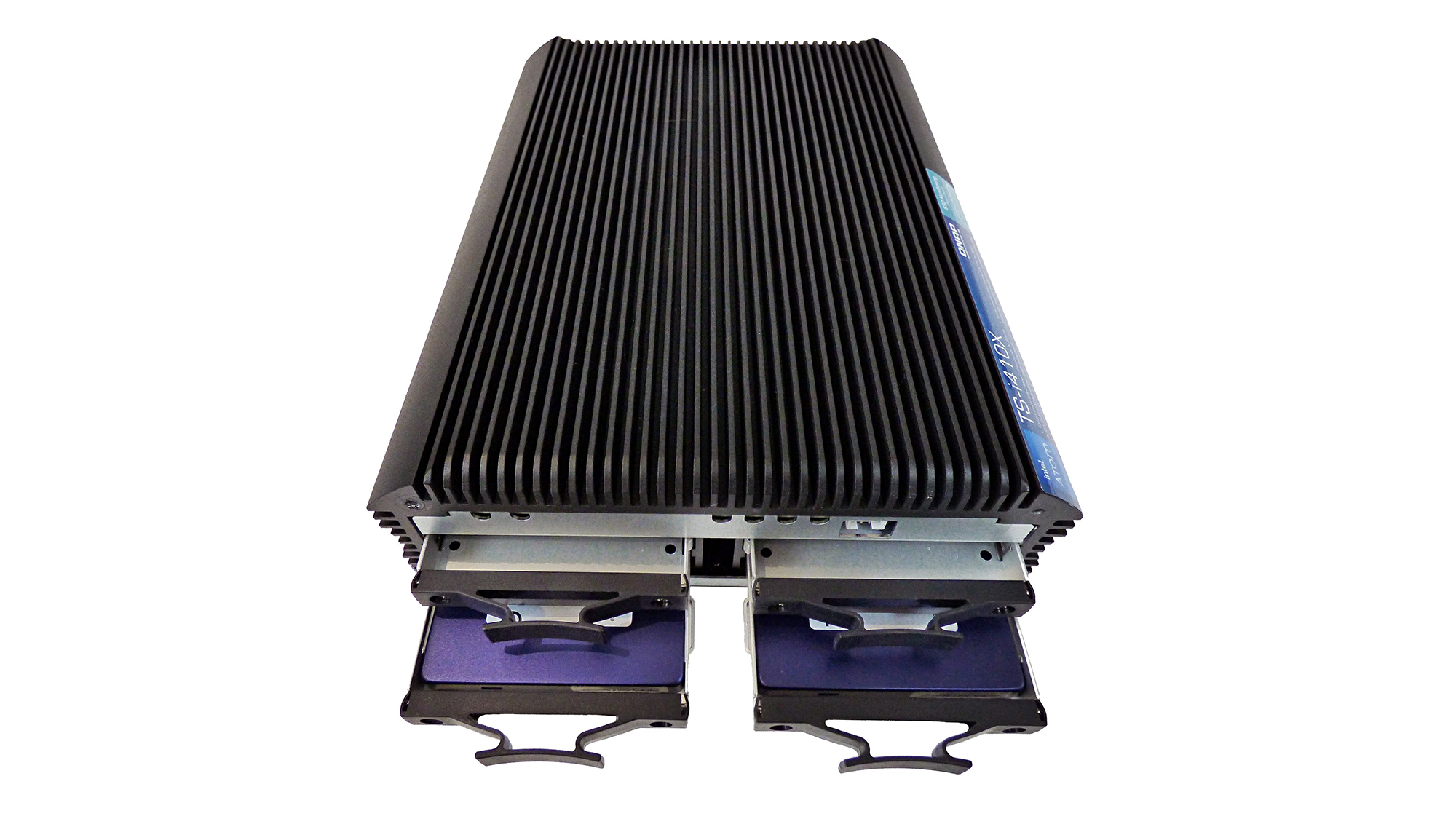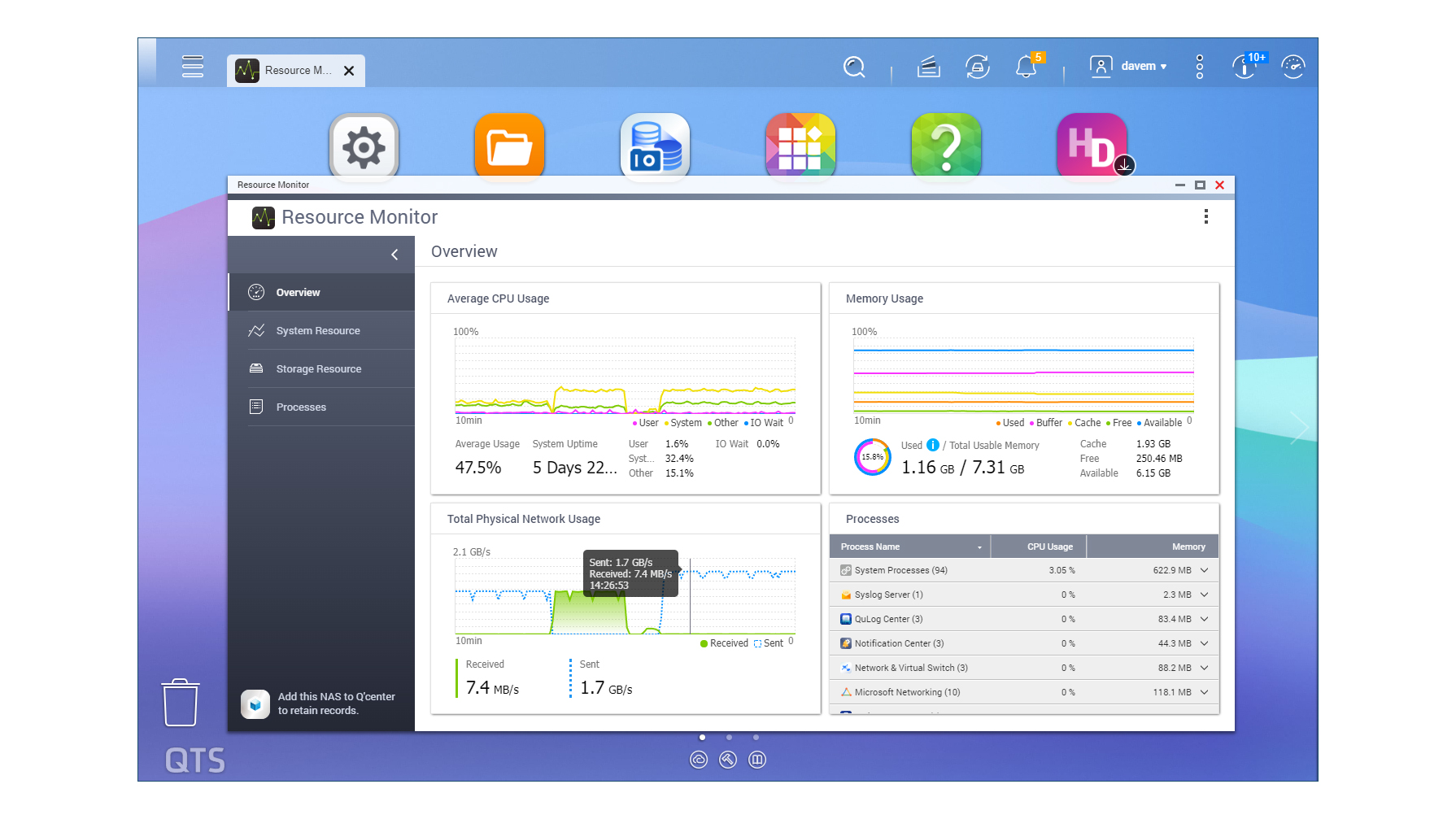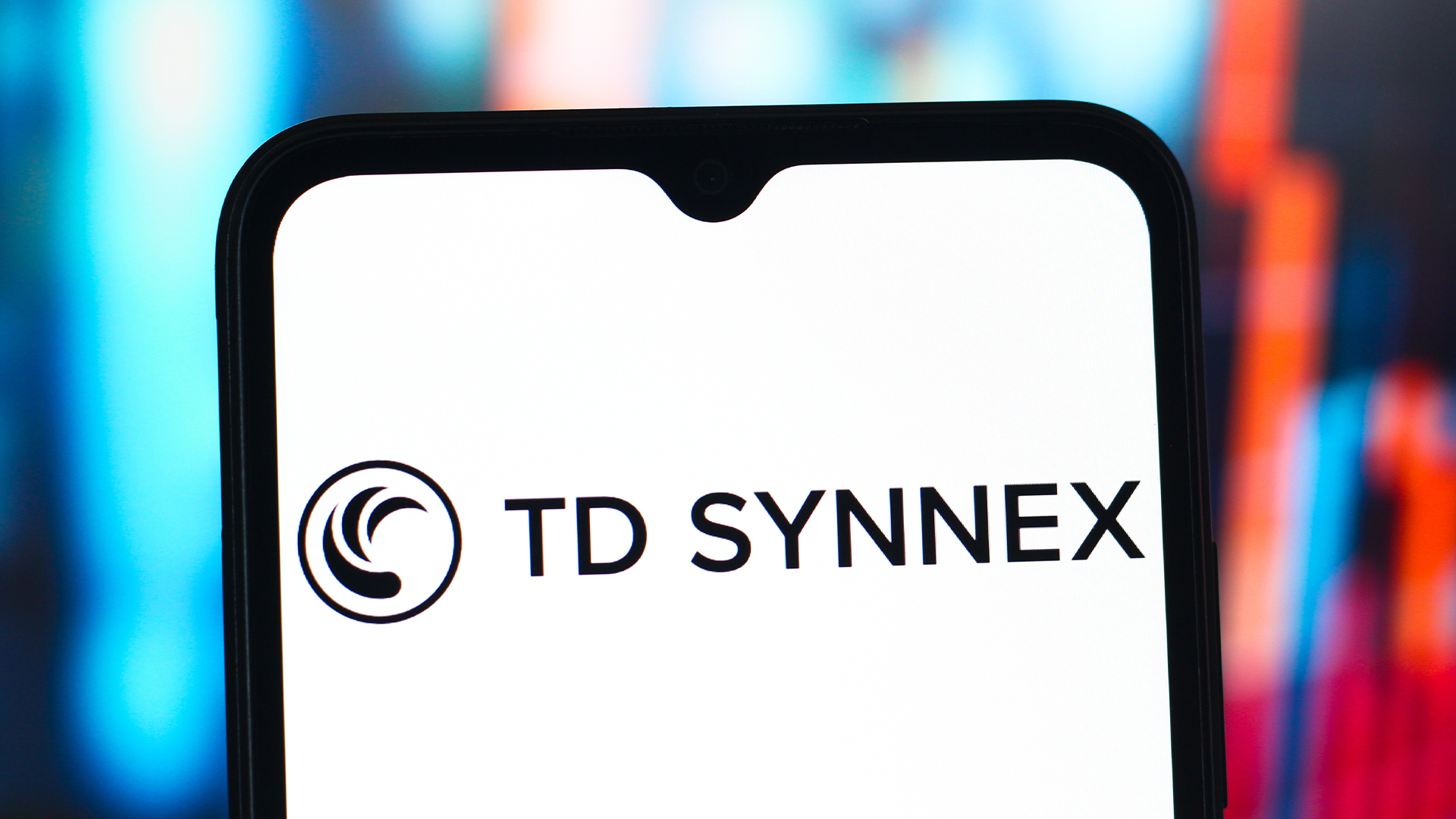Qnap TS-i410X review: Rock-solid network storage
Qnap’s rugged network storage appliance goes where other NAS fear to tread


-
+
Industrial-strength build quality
-
+
Tolerates a wide temperature range
-
+
Dual 10GbE ports
-
+
Great 10GbE performance
-
+
Feature-rich QTS software
-
-
Maximum 8GB of memory

Not a lot of people know this, but NAS specialist Qnap has been making ruggedised storage appliances for quite a few years. It entered this specialised market back in 2014 with the IS-400 Pro, upped its game at the end of 2015 with the IS-453S and after a seven year hiatus, has now launched the TS-i410X.
Designed in collaboration with Intel, the TS-i410X is aimed at a wide range of deployment scenarios including transportation, warehouses and factories. Built for harsh environments, it looks to have the right credentials: it’s clothed in an upgraded version of the battle-hardened aluminium and steel chassis used by its predecessors and is certified to operate in temperatures ranging from -40 to +70 degrees C.
This fanless unit uses its chunky finned aluminium casing to act as a massive heatsink and offers four internal hot-swap bays for SATA SFF SSDs. Processing power sees a big boost as the pensionable 1.9GHz Intel Atom E3845 from the IS-435S gets replaced with a more modern quad-core 2GHz Atom x6425E - but although memory is the faster DDR4 variety, the 8GB provided cannot be upgraded.
The 12W TDP Atom CPU is designed by Intel for extended temperature operations and incorporates 10th Gen UHD graphics piped through to the appliance’s rear HDMI 1.4b port. Networking sees big improvements too, as the TS-i410X includes a pair of 10GbE ports that support multi-Gigabit speeds.
Qnap TS-i410X review: Hardware and design
Measuring 180 x 254 x 70mm (WDH), the TS-i410X is slightly larger than the IS-435S, thanks to the flared sides which increase the chassis surface area. Passive cooling is further improved by the thicker chassis material, which absorbs more heat as well as introducing a weight increase of over 1kg.

Along with the dual 10GbE and HDMI rear ports, you have a quartet of USB 3.2 Gen 2 ports which can be used to expand capacity outside the box, with Qnap offering five expansion units in rack or tower formats. There’s one catch though: none of these are fanless, ruggedised models, so they can’t be deployed alongside the TS-i410X in harsh environments.
However, you can network the appliance in these conditions, thanks to Qnap’s QSW-IM1200-8C ruggedised 12-port 10GbE switch. The appliance comes with a 96W external power supply unit and has a separate 2-pin socket for an optional 9-36V DC input.
Sign up today and you will receive a free copy of our Future Focus 2025 report - the leading guidance on AI, cybersecurity and other IT challenges as per 700+ senior executives
Installing SSDs is easy enough, and the four hot-swap aluminium drive carriers are accessed by unscrewing and removing the front panel. For testing, we fitted two 1.92TB Micron SATA SSDs but to operate the appliance at the upper end of its temperature range, you should consider industrial-grade SSDs such as the Exascend SI3 which can handle from -40 up to +85 degrees C.
Qnap TS-i410X review: Deployment and QTS 5
Following the web-based quick start wizard to install the latest QTS 5 software is a swift process. The TS-i410X sadly doesn’t support Qnap’s QuTS OS, as many features, such as caching, require more than 8GB of memory.
This isn’t a deal breaker though, as QTS offers a wealth of business apps including plenty of data protection services. You can run on-demand and scheduled snapshots for NAS shares and iSCSI LUNs on standard EXT4 volumes and easily create a data backup strategy using the smart Hybrid Backup Sync (HBS) 3 app.

The appliance makes a great discrete IP camera monitoring and recording solution, with the free version of Qnap’s QVR Pro app including an 8-channel license and supporting 14 days of video playback. Extra camera licenses can be purchased with prices starting at around £307 for an extra 8 channels, which also enables unlimited playback.
The appliance can host virtual machines via the Container Station, Ubuntu Linux Station and Virtualization Station apps. However, the maximum 8GB of memory will once again limit the number of VMs it can present.
Qnap TS-i410X review: 10GbE performance
With the dual SSDs configured in a mirror, we mapped a NAS share over 10GbE to a Dell EMC PowerEdge T640 Xeon Scalable server running Windows Server 2019. Iometer reported very good speeds, with sequential read and write rates settling at 9.3Gbits/sec and 9.2Gbits/sec.
These translated to good real world speeds; drag and drop copies of a 25GB test file averaged read and write speeds of 8Gbits/sec and 4Gbits/sec. Backup performance is just as good, and securing a 22.4GB folder with 10,500 small files to the share averaged a tidy 2Gbits/sec. The Atom CPU handled encryption duties well, too. Copying the 25GB test file to an encrypted share averaged 2.3Gbits/sec with CPU utilisation peaking at 62%.
Moving over to IP SANs saw equally good speeds, with a 500GB iSCSI LUN mustering Iometer sequential read and write speeds of 9.2Gbits/sec and 9.1Gbits/sec. Using the appliance’s second port, we then created a dual 10GbE MPIO link to the target and saw read and write speeds ramp up nicely to 13.2Gbits/sec and 12.2Gbits/sec although CPU usage hit 91%.

The August heatwave came in handy for testing the chassis’ cooling efficiency. We placed the appliance in an unventilated room during all four days and although the ambient room temperature reached 37 degrees C, we could see from the QTS hardware information page that the system, CPU and SSDs never went beyond 46 degrees C.
Qnap TS-i410X review: Verdict
The TS-i410X is aimed at a niche market, with much of its competition coming from manufacturers such as ioSafe, Eurotech, Nexcom and Galleon. However, most of the latter are a lot more expensive, as many are built for specialist markets such as the defense and aerospace industries.
As a general-purpose ruggedized NAS, the TS-i410X is better value and Qnap’s QTS software makes it much more versatile, too. The maximum 8GB of memory places some limitations on the number of apps it can run, but this little desktop tank can’t be faulted for build quality or 10GbE performance.
Qnap TS-i410X review specifications
| Chassis | Desktop chassis |
| CPU | 2GHz quad-core Intel Atom x6425E |
| Memory | 8GB DDR4 (non-upgradeable) |
| Storage | 4 x SATA SFF SSD bays |
| RAID | RAID0, 1, 5, 6, 10 |
| Expansion | None |
| Network | 2 x 10Gbase-T Multi-Gigabit |
| Other ports | 4 x USB 3.2 Gen 2, HDMI 1.4b |
| Power | External 96W PSU |
| Management | Web browser |
| Warranty | 3 year limited |
Dave is an IT consultant and freelance journalist specialising in hands-on reviews of computer networking products covering all market sectors from small businesses to enterprises. Founder of Binary Testing Ltd – the UK’s premier independent network testing laboratory - Dave has over 45 years of experience in the IT industry.
Dave has produced many thousands of in-depth business networking product reviews from his lab which have been reproduced globally. Writing for ITPro and its sister title, PC Pro, he covers all areas of business IT infrastructure, including servers, storage, network security, data protection, cloud, infrastructure and services.
-
 UK say firms say no to AI job cuts: 32% expect to hire more staff as leaders double down on ‘specialist roles’ and productivity gains
UK say firms say no to AI job cuts: 32% expect to hire more staff as leaders double down on ‘specialist roles’ and productivity gainsNews There's good news for British workers worried about AI job cuts, with new research showing that 78% of business leaders don't expect its to lead to a drop in headcount.
By Emma Woollacott Published
-
 TD Synnex launches new workshop to help partners drive AI adoption
TD Synnex launches new workshop to help partners drive AI adoptionNews The distributor’s new AI Game Plan will aid partners in identifying and prioritizing customer AI use cases
By Daniel Todd Published
-
 Google is scrapping its dark web report feature — here's everything you need to know and some alternative options
Google is scrapping its dark web report feature — here's everything you need to know and some alternative optionsNews Google said while the dark web report feature offered “general information”, the tool didn’t provide “helpful next steps” for users potentially impacted by a breach.
By Emma Woollacott Published
